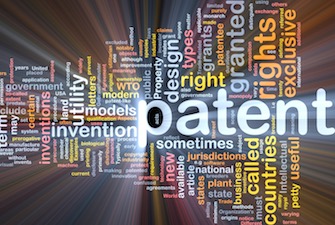 A patent is a proprietary right granted by the Federal government pursuant to laws passed by Congress. Patents, which convey to the owner exclusive rights to the claimed invention, are granted to inventors who file an application with the United States Patent and Trademark Office (USPTO).
A patent is a proprietary right granted by the Federal government pursuant to laws passed by Congress. Patents, which convey to the owner exclusive rights to the claimed invention, are granted to inventors who file an application with the United States Patent and Trademark Office (USPTO).
There are three types of patents available in the United States: (1) a utility patent, which covers the functional aspects of products and processes; (2) a design patent, which covers the ornamental design of useful objects; and (3) a plant patent, which covers a new variety of living plant. Each confers “the right to exclude others from making, using, offering for sale, or selling” the invention in the United States or importing the invention into the United States. Generally speaking, when one speaks of “a patent” generically, the reference is to a utility patent. Again, generally speaking, if a design or plant patent are being discussed the qualifying terms “design” or “plant” are almost universally included in the discussion.
It is important to note, however, that patents do not protect ideas, but rather protect inventions that exhibit subject matter deemed allowable. In other words, any exclusive rights you obtain can only protect something that is considered patent eligible. Generally speaking, in the United States the view of what is eligible for protection has historically been quite broad. Machines, compounds and processes are all eligible, for example.
Even living organisms that have been genetically engineered in a laboratory can be protected (see Diamond v. Chakrabarty). Business methods are also eligible for protection in the United States (see here, here, and here). Software is likewise eligible, although obtaining a software patent in the United States is not as easy as it once was and the application you must file will need comprehensive discussion of the underlying technology (see here and here). Even some man-made DNA can be protected (see AMP v. Myraid Genetics, which ruled some cDNA eligible).
Thus, it is typically more helpful and enlightening to discuss what is not eligible for protection: Laws of nature, abstract ideas, naturally occurring phenomena, so-called naked business methods (i.e., not tethered to any kind of machine or apparatus), inventions only capable of an illegal purpose, atomic weapons, tax strategies, and human organisms (which the statute does not define but likely relates to embryos and fetuses). Notwithstanding, for the most part, chances are that whatever you have invented can be characterized so that eligibility will not be a significant impediment to exclusive rights.
But where does this power of Congress come from? The simple answer is that it comes directly from the U.S. Constitution.
The Genesis of U.S. Patent Laws ~ The U.S. Constitution
None other than James Madison stated in Federalist Paper No. 43, the usefulness of the Congresses power to award patents “will scarcely be questioned.” Madison, Debates in the Federal Convention of 1787, at 512-13 (Hunt and Scott ed. 1920). Madison, known as the Father of the Constitution, was the primary proponent of strong rights and even convinced the skeptical Thomas Jefferson that without strong rights there would be insufficient incentive to take risks and innovate.
So evident was the power to award patents that little information on the discussion had by the Founding Fathers during the Constitutional Convention was recorded. We do know that the Constitution itself grants to the Congress the power. This power is found in Article I, Section 8, Clause 8, which specifically gives Congress the power:
To promote the progress of science and useful arts, by securing for limited times to authors and inventors the exclusive right to their respective writings and discoveries;
The reason the U.S. Constitution grants Congress the power to legislate in the area of intellectual property is to “promote the Progress of Science and useful Arts.” It is interesting to note that the word “science” refers to protection of copyrightable subject matter and the term “useful arts” refers to the protection of inventions. Giles Sutherland Rich, the father of the 1952 Patent Act and long time Judge on the United States Court of Appeals for the Federal Circuit, explained this in an address at Franklin Pierce Law Center in 1994:
[O]ver a time of two centuries, the meaning of even common words may change. “Science” as we use it today does not have the connotation it did in 1787 when it referred to knowledge in general, in all fields of knowledge. What we mean today by “science” was then called natural philosophy. It was quite clearly intended by the authors of the Constitution that copyright, not patents, was intended to promote science, and the province of rights granted to inventors respecting their “Discoveries” was to promote the “useful Arts.” Yet we find never ending references in the opinions of Federal Judges, perhaps looking at the patent clause for the first time, and taking what is there written at face value, to the promotion of “Science and the useful Arts” by the issuance of patents.
35 IDEA 1, 2 (1994).
Unlike most of the enumerated powers granted to Congress in the Constitution, the Intellectual Property Clause is a qualified grant of power, which does limit Congressional discretion in at least some ways. For example, Congress may not simply create an exclusive right with a term of unlimited duration given that the express language of the Constitution says the rights may only be given for “limited times.”
Notwithstanding the evolution of the Constitutional language, exclusive rights are provided for a limited time as an incentive to inventors, entrepreneurs and corporations to engage in research and development, to spend the time, energy and capital resources necessary to create useful inventions; which will hopefully have a positive effect on society through the introduction of new products and processes of manufacture into the economy, including life saving treatments and cures. See Kewanee Oil Co. v. Bicron Corp., 416 U.S. 470, 480 (1974). See also Mazer v. Stein, 347 U.S. 201, 219 (1954) (“The economic philosophy behind the clause empowering Congress to grant patents and copyrights is the conviction that encouragement of individual effort by personal gain is the best way to advance public welfare through the talents of authors and inventors in ‘Science and useful Arts.’”); Universal Oil Products Co. v. Global Oil Refining Co., 322 U.S. 471, 484 (1944)(“As a reward for inventions and to encourage their disclosure, the United States offers a seventeen-year monopoly to an inventor who refrains from keeping his invention a trade secret.”)
In determining whether an invention worthy of protection does exist, the the invention claimed by the applicant must be new, useful and the embodiment of a scientific advance. This last requirement, the embodiment of a scientific advance, is what we have come to know today as the non-obviousness requirement. Although the concept of obviousness did not appear in the Patent Act itself until the 1952 revisions, it is clear that it has always been considered a prerequisite to patentability dating back to the earliest days of America’s patent system. Indeed, the concept of obviousness has been an explicit part of U.S. law since at least 1850 when the Supreme Court decided Hotchkiss v. Greenwood.
The reward of a patent, together with the requirements of utility, novelty and non-obviousness, represent a delicate balance struck between the need to encourage innovation and the avoidance of exclusive rights that stifle competition without providing any advantage to society. In implementing the permissive Constitutional authority, Congress is free to place requirements upon the acquisition of exclusive rights that further the goals of the clause, while at the same time not compromising the specific dictates of the grant of power.
Indeed, in so fashioning the laws to enhance the quid pro quo envisioned by the founding fathers, Congress has enacted certain description requirements that further the Constitutional goals, but which are not themselves found in the Constitution. This is hardly surprising given the Constitution is not a document known for its length and specificity. Instead, the Constitution is a guiding document that sets out organizing principles. The details are left to Congress, and in turn can be delegated to the agency in charge, which in this case is the USPTO. In any event, the description requirement (see here, here and here) which places the burden on the applicant to adequately, fully and fairly describe the invention is within the province of Congress to mandate.
Although copyrights and patents are authorized by the same clause in the Constitution, it is perhaps interesting to note that the utility requirement does not have an analogous copyright counterpart. Indeed, the development of copyright law and patent law has been quite different. This is in no small part due to the length of the term of the rights. For copyrights the term is exceptionally long, running for 70 years plus the life of the author, which can mean that copyrights can easily last for 100 to 150 years, or longer. As a result there are a variety of statutory provisions that mandate the sharing of copyrights with the public, meaning a copyright is not a true exclusive right. For example, under copyright law there are fair use rights (17 U.S.C. 107) and a first sale doctrine (17 U.S.C. 109(a)). Patent law does not have any similar statutory provisions or concepts.
In any event, if creations are to be copyrightable they cannot be useful, and must have some design features that exist separately from any utilitarian features. Likewise, with copyrights there is no endeavor to quantify or qualify artist merit prior to a copyright attaching to an original, copyrightable creation. Nevertheless, the remaining two requirements, namely the novelty and non-obviousness requirements, can be analogized with the single constitutional requirement for copyrights, namely originality. The purpose of the novelty and non-obviousness requirements is to ensure that an invention does indeed exist. Similarly, the purpose of the originality requirement is to ensure that something worthy of copyright protection has been created. The invention and creation requirements find commonality in that only creations of the mind that are fresh, unfamiliar and different are deserving of intellectual property protection.
Filing an Application
In order to obtain a exclusive rights in the United States it will be necessary to file an application. There are various types of applications that can be filed. These are:
It is also possible to file an International Application as well, which can be beneficial if you are interested in obtaining patent rights in multiple countries.
Further discussion of the various types of applications goes beyond the scope of this primer, but please do follow the above links to learn more about each. If you are interested in trying to file something on your own please see Do it Yourself Patents.
More Information
The pages of IPWatchdog.com are full of information, tutorials and resources to learn more please see:
- Patent Basics: Practice Tips for Achieving Success in Inter Partes Reviews
- An Alternative to Claim Mirroring in Initial Patent Application Filing
- IP Goes Pop! You Can’t Do That – What IP Cannot Protect
- How to Use the USPTO Patent Public Search Tool
- Using Analytics to Assess the Effectiveness of Common Patent Prosecution Practices
- Tips from a Former Examiner on How to Conduct Interviews at the USPTO
- Ten Mistakes to Avoid When Drafting Information Disclosure Statements
- Defanging Descriptive Material Rejections
- Can You Refile a Provisional Patent Application?
- Ten Common Patent Claim Drafting Mistakes to Avoid
- It’s All in the Hardware: Overcoming 101 Rejections in Computer Networking Technology Classes
- Disclosure Requirements in Software Patents: Avoiding Indefiniteness
- Patent Procurement and Strategy for Business Success Part III: Prosecution – Wielding an Invisible Hand
- Patent Procurement and Strategy for Business Success Part II: Claims – Targeting the Right Infringers
- Patent Procurement and Strategy for Business Success: Building and Strategically Using Patents that Target the Right Infringers and Thwart Competitive Countermeasures
- Fit to Drive: Three Inspiring Office Action Responses from the USPTO’s Art Unit 3668
- Design Patents 101: Understanding Utility Patents’ Lesser-Known Cousin
- Two Key Steps to Overcome Rejections Received on PCT Drawings
- Errors in Issued Patents as a Measure of Patent Quality
- Intellectual Property for Startups: Building a Toolkit to Protect Your Products and Design
- Why the Patent Classification System Needs an Update
- Understanding What a Design Patent is Not
- Design Patents: Under Utilized and Overlooked
- Deciding Where to Obtain International Patent Rights
- When to Use the Patent Cooperation Treaty—and Why It’s So Popular
- Why and When Design Patents are Useful
- PCT Basics: Obtaining Patent Rights Around the World
- ipAwarenessAssessment: Inventors and Business Owners Should Start Their IP Journey with this USPTO-NIST Tool
- Successful After Final Petitions Can Help Advance Prosecution (Part V)
- From Agent to Examiner and Back Again: Practical Lessons Learned from Inside the USPTO
- WIPO’s INSPIRE Offers a New Way to Select Databases for Patent Searches Involving Machine Translations
- Understand Your Utility Patent Application Drawings
- Why It’s Time to Board the PCT Train: The Benefits of Filing U.S. Patent Applications via the PCT First
- Implications of Filing Subsequent Patent Applications in the United States (Part III)
- Types of Subsequent Patent Applications in the United States (Part II)
- Getting a Patent: The Devastating Consequences of Not Naming All Inventors
- Getting A Patent: Who Should be Named as An Inventor?
- Make Your Disclosures Meaningful: A Plea for Clarity in Patent Drafting
- Applying for a Patent in Germany
- Autopilot or Advocate? Raising the Bar in Ex Parte Appeals at the USPTO
- Time to ‘Think PCT’: Rethink Your Global Patent Strategy to Preserve Your Seat at the Table
- Patent Office Insights from Two Former Examiners
- Conventional Patent Wisdom Revisited
- Develop Your Database of Templates for Responding to Office Actions
- Background Pitfalls When Drafting a Patent Application
- Eight Tips to Get Your Patent Approved at the EPO
- Four Things C-Suite Executives Need to Know About Patents
- Starting the Patent Process on a Limited Budget
- What to Know About Drafting Patent Claims
- Beyond the Slice and Dice: Turning Your Idea into an Invention

![[IPWatchdog Logo]](https://ipwatchdog.com/wp-content/themes/IPWatchdog%20-%202023/assets/images/temp/logo-small@2x.png)

![[[Advertisement]]](https://ipwatchdog.com/wp-content/uploads/2018/10/Enhance-3-IPWatchdog-Ad-2499x833-3.png)
![[[Advertisement]]](https://ipwatchdog.com/wp-content/uploads/2018/08/Ad-1-The-Invent-Patent-System™-1.png)
![[Advertisement]](https://ipwatchdog.com/wp-content/uploads/2024/05/Quartz-IP-May-9-2024-sidebar-700x500-1.jpg)
![[Advertisement]](https://ipwatchdog.com/wp-content/uploads/2024/04/Patent-Litigation-Masters-2024-sidebar-last-chance-700x500-1.jpg)
![[Advertisement]](https://ipwatchdog.com/wp-content/uploads/2024/05/Patent-Portfolio-Management-2024-sidebar-super-early-bird-with-button-700x500-1.jpg)
![[Advertisement]](https://ipwatchdog.com/wp-content/uploads/2024/05/Artificial-Intelligence-2024-Getting-AI-Patents-Allowed-sidebar-700x500-1.jpeg)

![[Advertisement]](https://ipwatchdog.com/wp-content/uploads/2021/12/WEBINAR-336-x-280-px.png)
![[Advertisement]](https://ipwatchdog.com/wp-content/uploads/2021/12/2021-Patent-Practice-on-Demand-recorded-Feb-2021-336-x-280.jpg)
![[Advertisement]](https://ipwatchdog.com/wp-content/uploads/2021/12/Ad-4-The-Invent-Patent-System™.png)







Join the Discussion
2 comments so far.
Victor
March 25, 2016 05:36 am“Article I, Section 8, Clause 8
“”To promote the progress of science and useful arts, by securing for limited times to authors and inventors the exclusive right to their respective writings and discoveries;””
“”Congress may not simply create an exclusive right with a term of unlimited duration given that the express language of the Constitution says the rights may only be given for “limited times.”””
-from these statement, it’s clear that exclusive rights grant by congress in terms of US Constitution is given for the invention of “”limited time”” not for “”unlimited duration””.
Joachim Martillo
February 22, 2016 12:22 amMapping 18th century terminology to 21st century terminology
Natural philosophy = science
Science = Critical analysis, critical studies (compare with the German term Wissenschaft, which means science but which can also be used in Wissenschaft des Judentums to mean critical study of Judaism or Jewish studies)
Useful arts = engineering (engineer does not come from engine but comes from Old French engigneor or from Medieval Latin ingeniator meaning someone that contrives fortifications or weapons although the term railroad engineer meaning train driver may involve a sort of conflation of the word engineer with the word engine)
Note that classically there is little distinction between architecture and civil or military engineering as De Architectura by Vitruvius demonstrates.